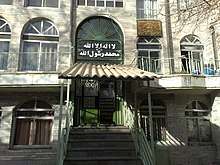Naqshbandi
The Naqshbandi (Persian: نقشبندی) or Naqshbandiyah (Arabic: نقشبندية, romanized: Naqshbandīyah), is a major Sunni spiritual order of Sufism. It got its name from Baha-ud-Din Naqshband Bukhari. Some Naqshbandi masters trace their lineage through Ali,[1] his son-in-law and successor, in keeping with most other Sufis.[2][3] In Iraq, people belonging to the Army of the Men of the Naqshbandi Order are fighting the Iraqi government intending to get their country back from "American control".
| Part of a series on Islam Sufism |
|---|
|
List of sufis |
|
|

Spiritual lineage criteria
In Sufism, as in any serious Islamic discipline such as jurisprudence (fiqh), Quranic recital (tajwid) and hadith, a disciple must have a master or sheikh from whom to take the knowledge, one who has himself taken it from a master, and so on, in a continuous chain of masters back to Muhammad. According to Carl W. Ernst:[4]
Within the Sufi tradition, the formation of the orders did not immediately produce lineages of master and disciple. There are few examples before the eleventh century of complete lineages going back to the Prophet Muhammad. Yet the symbolic importance of these lineages was immense: they provided a channel to divine authority through master-disciple chains. It was through such chains of masters and disciples that spiritual power and blessings were transmitted to both general and special devotees.
This means that a Sufi master has met and taken the way from a master and that during his lifetime he has explicitly and verifiably invested the disciple—whether in writing or in front of a number of witnesses—as a fully authorized master (murshid ma’dhun) of the spiritual path to succeeding generations of disciples.
Such spiritual transmission from an unbroken line of masters is one criterion that distinguishes a true or 'connected' Sufi path (tariq muttasila), from an inauthentic or "dissevered" path (tariq munqati‘a). The leader of a dissevered path may claim to be a Sufi master on the basis of an authorization given by a master in private or other unverifiable circumstance or by a figure already passed from this world, such as one of the righteous person or Muhammad or in a dream or so on. These practices only "warm the heart" (yusta’nasu biha) but none meets Sufism's condition that a Sufi master must have a clear authorization connecting him with Muhammad, one that is verified by others than himself.
Spreading of the order
The Naqshbandi order owes many insights to Yusuf Hamdani and Abdul Khaliq Gajadwani in the 12th century, the latter of whom is regarded as the organizer of the practices and is responsible for placing stress upon the purely silent invocation.[5] It was later associated with Baha-ud-Din Naqshband Bukhari in the 14th century, hence the name of the order. The name can be interpreted as "engraver (of the heart)", "pattern maker", "reformer of patterns", "image maker", or "related to the image maker". The way is sometimes referred to as "the sublime sufi path" and "the way of the golden chain."
The path's name has changed over the years. Referring to Abu Bakr as-Siddiq, it was originally called "as-Siddiqiyya"; between the time of Bayazid al-Bistami and Abdul Khaliq al-Ghujdawani "at-Tayfuriyya"; from the time of 'Abdul Khaliq al-Ghujdawani to Shah Naqshband the "Khwajagan" or "Hodja"; from the time of Shah Naqshband and on "an-Naqshbandiyya".
Afterwards, a branch or sub-order name was added. From 'Ubeydullah Ahrar to Imam Rabbani, the way was called "Naqshbandiyya-Ahrariyya"; from Imam Rabbani to Shamsuddin Mazhar "Naqshbandiyya-Mujaddadiyya"; from Shamsuddin Mazhar to Mawlana Khalid al-Baghdadi "Naqshbandiyya-Mazhariyya"; from Mawlana Khalid onwards "Naqshbandiyya-Khalidiyya"; "Naqshbandiyya-Mustafvi" (Khalidi) and so on.[6]
The way or school connected to the late Shaykh Sultan ul-Awliya Moulana Sheikh Nazim, who lived in Northern Cyprus, is undoubtedly the most active of all Naqshbandi orders with followers in almost every corner of the World. It is referred to as the "Naqshbandi-Haqqani" way. According to some estimates there are over sixty million disciples, and centres in almost every country of the world. It also had the largest internet presence. There are disciples in almost all of Europe including the United Kingdom, Germany, and France, and in the United States of America, the Middle East, Africa, India, Bangladesh, China, Japan, Australia, New Zealand, Latin America, etc. It is most active in Indonesia, Malaysia, Sri Lanka and Pakistan. As well as being the most prevalent Sufi Order in the west. The Prince of Malaysia, Raja Ashman Shah was a disciple of this order.
South Asia
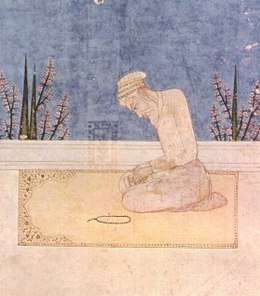
The Naqshbandiyya order became an influential factor in Indo-Muslim life and for two centuries it was the principal spiritual order in the Indian Subcontinent. Baqi Billah Berang (No. 24 in the Naqshbandi-Haqqani Golden Chain) is credited for bringing the order to India during the end of the 16th century. He was born in Kabul and brought up and educated in Kabul and Samarqand, where he came in contact with the Naqshbandiyya order through Khawaja Amkangi. When he came to India, he tried to spread his knowledge about the order, but died three years later.[7]
Among his disciples were Sheikh Ahmad Sirhindi (No. 25 in the Naqshbandi-Haqqani Golden Chain) and Sheikh Abdul Haq of Delhi. After his death, his student, Sheikh Ahmad primarily took over. Sheikh Ahmad was born in 1561 and his father Makhdum Abdul Ahad was from a high Sufi order. He completed his religious and secular studies at the age of 17. Later he became known as Mujaddad-i-Alf-i-Thani. It was through him that the order gained popularity within a short period of time.[7]
Sheikh Ahmad broke away from earlier mystic traditions and propounded his theory of the unity of the phenomenal world. In particular, he spoke out against innovations introduced by Sufis. For instance, he opposed Emperor Akbar's views on Hindu and Muslim marriages. He stated, "Muslims should follow their religion, and non-Muslims their ways, as the Qur'an enjoins 'for you yours and for me my religion'". Also he did not believe in keeping the state and ruler separate and worked hard to change the outlook of the ruling class. After his death, his work was continued by his sons and descendants.[8]
In the 18th century Shah Wali Allah played an important role in the religious sciences, particularly the hadith and translated the Qur'an into Persian. He also looked at a fresh interpretation of Islamic teachings in the light of the new issues. Furthermore, he played a significant role in the political developments of the period.
During the 19th century two Naqshbandiyya saints made significant contributions to the chain (silsila) by restating some of its basic ideological postures
Currently the South Asian region's most widespread branch of the Naqshbandi Tariqah is the Mujaddidi branch. Maulana Shmas ur Rahman Al Abbasi, a well known scholar, has been actively illuminating the lives of thousands. His Senior most deputy Shaykh Humayun Hanif Naqshbandi Mujaddidi is amongst one of the eminent Sufi Shaykhs of Silsisla Aaliya Naqshbandia. Shaikhu-t-Tareeqah wa Sharee'ah Mawlana Muhammad Qawmaru-z-Zamaan AllahabadI, Shaykh Muhammad Mohsin Munawar Yousafi Naqshbandi Mujaddidi and Peer Zulfiqar Ahmad Naqshbandi are the leading sheikh's in spreading the silsilah in the region and has more than 250 deputies to aid in that effort. In Pakistan Noor Muhammad Curahi and his son Faqir Muhammad curahi from curah sharif near kohat led the chain in 20th century. They have more than 70 deputies including Pir Ghulam Nabi Hashmi, Pir Jamat Ali Shah and Pir jamat Ali lasani, Pir karmanwala, Pir Sharaqpuri and Eidgah sharif and many more.
Syria and Palestine
The Naqshbandiyya was introduced into Syria at the end of the 17th century by Murad Ali al-Bukhari, who was initiated in India. Later, he established himself in Damascus, but traveled throughout Arabia. His branch became known as the Muradiyya. After his death in 1720, his descendants formed the Muradi family of scholars and sheikhs who continued to head the Muradiyya. In 1820 and onward, Khalid Shahrazuri rose as the prominent Naqshbandi leader in the Ottoman world. After the death of Khalid in 1827, his order became known as the Khalidiyya, which continued to spread for at least two decades. In Syria and Lebanon, the leaders of every active Naqshbandiyya group acknowledged its spiritual lineage, which had retained the original Naqshbandiyya way. Later a strife between Khalid's khalifas led to disruption of the order, causing it to divide.[9]
When political leader Musa Bukhar died in 1973, the pre-Mujaddidi line of the Naqshbandiyya in Greater Syria came to an end. One of the only branches to have survived till recently is the one based in the khanqah al-Uzbakiyya in Jerusalem. The number of its members had increased at the end of the 19th century. The Farmadiyya branch, which practices silent and vocal invocation, is still present in Lebanon and is named after Ali-Farmadi.[9]
We shall speak about the Great Grandsheikh Abdullah Fa'izi ad-Daghestani (d. 1973), and quote a small passage from his Biography written by Sheikh Hisham Kabbani:
Sheikh Abdullah moved to Homs, where he visited the mosque and tomb of the Companion of the Prophet, Khalid ibn al-Walid. He stayed briefly in Homs. He moved to Damascus, in the Midan District, near the tomb of Sa`d ad-Din Jibawi, a saint from the family of the Prophet. There he established the first zawiya for the branch of the Naqshbandi Order which had gone to Daghestan. With him the Golden Chain of the Naqshbandi Order which had gone from Damascus to India, Baghdad, and Daghestan, now returned to Damascus.
His two daughters were married, Rabiha had four children, three girls and one boy. Madiha was married to Shaykh Tawfiq al-Hibri, one of the great Islamic scholars of Lebanon.
Soon people began to crowd into his zawiya. They arrived there from all over the city: Sufis, government people, businessmen, and common people. Murids were coming every day to sit at the door of his khanqah. Daily they served food to hundreds, many of whom also slept there.
Then he received a spiritual order to move to the Mountain of Qasyun. It is the highest point in Damascus, from whose vantage the entire city can be viewed. With the help of his two senior murids, Shaykh Muhammad Nazim 'Adil and Shaykh Husayn 'Ali, he built a house. This house and the mosque next to it still stand, and the mosque is the site of his maqam (shrine). He saw in a vision, while he was building the mosque, that the Prophet, with Shah Naqshband and Sayyidina Ahmad al-Faruqi, came and put posts to mark the shape and location of the walls of the mosque. As soon as the vision ended, the markers were visible, and everyone present saw them. At that mosque, over the years, hundreds of thousands of visitors were received: for healing, for prayers, for training, for all kinds of external and internal knowledge.
It was in Damascus, Syria, that Grandsheikh Abdullah Fa'izi ad-Daghestani, preached from, and also died. His blessed tomb is to be found in Damascus. It is estimated that a massive crowd of about 400,000 people attended his funeral (see Sheikh Hisham Kabbani's book on the Forty Grandsheikhs of the Naqshbandi Sufi path ). Lately the Naqshbandi Haqqani Sufi Order was led by his successor Nazim Al-Haqqani and might still be very active in Syria.
Dagestan, Russia
Naqshbandi silsilah beginning from Muhammad is passed in chain till Ismail Kurdumeri (who is No. 31 in the Naqshbandi-Haqqani Golden Chain). After Ismail Kurdumeri the chain has split in two as he had two Ma'zuns, i.e. Muhammad Salih Shirwani (No. 32) and Khas Muhammad Shirwani. From Khas Muhammad Shirwani the chain goes to Muhammad Yaraghi ad-Daghestani (in Daghestan), and from him to Jamaluddin al-Ghumuqi ad-Daghestani, who had three Ma'zuns, i.e. Mamadibir ar-Rochi ad-Daghestani, Imam Shamil ad-Daghestani (both had no Ma'zun), and 'Abdurrahman Abu Ahmad as-Sughuri ad-Daghestani. According to Shuaib Afandi Bagini ad-Daghestani, 'Abdurrahman as-Sughuri had two ma'zuns, i.e. Muhammad Haji 'Obodi ad-Daghestani and Ilyas Tsudakhari ad-Daghestani (d. 1312 AH). Both had no ma'zuns, and thus the split chain coming from Khas Muhammad Shirwani has ended here.. There are strict requirements as to who gives the permission, how it is given and received. The chain from Muhammad Salih Shirwani (No32) on the other hand, is continuous and goes all the way to Mahmud Afandi, Hasan Hilmi Afandi and the rest of the Daghestani Ma'zuns.[10] The Naqshbandi Haqqani Sufi Order has roots in Dagestan through Muhammad al-Madani, the successor of Abu Ahmad as-Sughuri and his successor Abdullah Fa'izi ad-Daghestani and his successor and Grandshaykh of the order Nazim al-Haqqani.
Egypt
During the middle of the 19th century Egypt was inhabited and controlled by Naqshbandis. A major Naqshbandi khanqah was constructed in 1851 by Abbas I, who did this as a favor to Naqshbandi sheikh Ahmad Ashiq. Ahmad Ashiq headed the order till his death in 1883. Ahmad Ashiq's was a practicer of the Diya'iyya branch of the Khalidiyya. In 1876 sheikh Juda Ibrahim amended the original Diya’iyya, which became known as al-Judiyya, and gained a following in al-Sharqiyya province in the eastern Nile Delta.[9]
During the last two decades of the 19th century two other versions of Naqshbandiyya spread in Egypt. One of these was introduced by a Sudanese, alSharif Isma'il al-Sinnari. Al-Sinnari had been initiated into the Khalidiyya and Mujaddidiyya by various sheikhs during his time in Mecca and Medina. Initially, he tried to obtain a following in Cairo but was not able to, therefore he resorted going to Sudan. It is from there that the order spread into Upper Egypt from 1870 onward under Musa Mu’awwad, who was al-Sinnari's successor. Muhaamad al-Laythi, son of al-Sinnari, was the successor after Mu’awwad's death.[9]
The Judiyya and the Khalidiyya branches spread in the last decades of the 19th century and continued to grow and are still active today. Khalidiyya of Muhammad Amin al-Kurdi is headed by his son Najm a-Din. The Judiyya split into three main branches:one led by the founder's son Isa, another led by Iliwa Atiyya in Cairo, and another led by Judah Muhammad Abu’l-Yazid al-Hahdi in Tanta.[9]
Unfortunately, none of the early orders survived far into the 20th century. The longest living group of khanqah based Naqshbandis lived in the khanqah of sheikh Ahmad Ashiq, which closed in 1954. This is when all the khanqahs in Egypt were closed and the awqaf supporting these establishments were taken over by the Ministry of Awqaf. The buildings were either assigned a different function or demolished as part of urban renovation programs.[9]
China
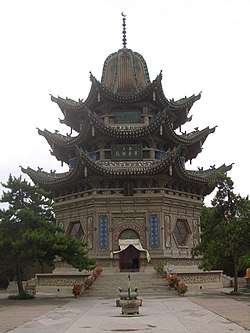
Ma Laichi brought the Naqshbandi (نقشبندية) 納克什班迪 order to China, creating the Khufiyya (خفيه) 虎夫耶 Hua Si Sufi 华寺; ("Multicolored Mosque") menhuan. Ma Mingxin, also brought the Naqshbandi order, creating the Jahriyya (جهرية) 哲赫林耶 menhuan. These two menhuan were rivals, and fought against each other which led to the Jahriyya Rebellion, Dungan revolt, and Dungan Revolt (1895).[11]
Some Chinese Muslim Generals of the Ma Clique belonged to Naqshbandi Sufi menhuan including Ma Zhan'ao and Ma Anliang of the Khufiyya Naqshbandi menhuan. Ma Shaowu, and Ma Yuanzhang were other prominent leaders from the Jahriyya Naqshbandi menhuan.
Many disciples of the Naqshbandi Haqqani Sufi Order remain in China today.
Prominent sheikhs
Baha-ud-Din Naqshband Bukhari
Baha-ud-Din Naqshband Bukhari (1318–1389) was the founder of the Sufi Naqshbandi Order. He was born in the village of Qasr-i-Hinduvan near Bukhara.[12]
Ahmad Sirhindi
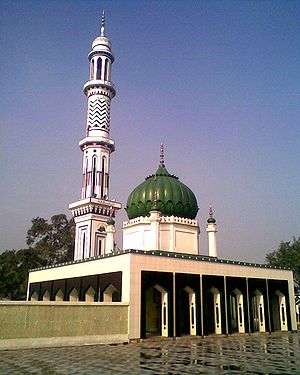
Shaykh Ahmad al-Farūqī al-Sirhindī (1564–1624) was considered a Mujaddid and a leading Naqshbandi Sheikh from India. He was from an ashraf family claiming descent from caliph Umar, he received most of his early education from his father, Shaykh 'Abd al-Ahad and memorised the Qur'an. He was trained in all Sufi orders by the age of 17 and was given permission to initiate and train followers in the Naqshbandi Order.
Sheikh Ahmad made revolutionary changes to the Mughal empire. He persuaded Jahangir to disallow drinking alcohol and destruction of pubs and clubs. He made the Emperor revert the rule of exemption of sacrificing cows. Instead, religious conferences and meetings for spiritual development (known as halqas) were held throughout the territory.
Aside from this, Sheikh Ahmad wrote several letters to his murideen (pupils) and khulafa in Turkish and Arabic. These letters are a marvelous collection of spiritual knowledge and religious information. Later these were collected and preserved in book form by Dr. Ghulam Mustafa Khan, and translated to Urdu by Syed Zawar Hussain Shah. This book is known as Maktoobat, and, as Ghulam Mustafa says, is the best and most knowledgeable book after Quran and Hadith and are applicable for all problems to rise within 1000 years. For this purpose, Sheikh Ahmad is known as Mujaddid Alif Sani.
Sheikh Ahmad's three sons died in a plague, all religious and spiritually well developed. These included Muhammad Sadiq, Muhammad Farrukh and Muhammad Isa, his favorite son being Muhammad Sadiq, the eldest. His death caused Sheikh Ahmad immense sorrow, but he says that bearing this pain of loss gave him so many divine rewards that he'd have been not given them for any other deed.
Practices
Criteria of a sheikh
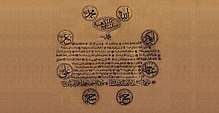
The following would always apply to genuine Sufi Naqshbandi teachers or sheikhs:
- They comply with the law.
- They must adhere to the Sunnah.
- They must be scholars. There can be no Sufism without knowledge.
- They must not engage in Bid'ah (religious innovation).
- Spiritual allegiance is openly and regularly given to the leader of the order, not the local teacher or sheikh.
- They accept interaction with other disciples of the order.
- They do not accept personal certification of dead persons, or in dreams, or through special spiritual experience (rawhani). There are exceptions to this rule according to the uwaisi concept of transmission where someone who lived before can train and transmit knowledge to someone who came later.
- They only accept written personal certification in the presence of witnesses.
11 principal teachings

Known as the Eleven Naqshbandi principles, the first eight were formulated by Abdul Khaliq Gajadwani, and the last three were added by Baha-ud-Din Naqshband Bukhari.[5]
- Remembrance (Yaad kard – Persian: یاد کرد): Always orally and mentally repeating the dhikr.
- Restraint (Baaz gasht – Persian: بازگشت ): Engaging in the heart repetition of the al-kalimat at-tayyiba phrase – "La-ilaha il-allah muhammadur rasul-allah".
- Watchfulness (Nigaah daasht – Persian: نگاه داشت): Being conscientious over wandering thoughts while repeating Al-kalimat at-tayyiba.
- Recollection (Yaad daasht – Persian: ياد داشت): Concentration upon the Divine presence in a condition of dhawq, foretaste, intuitive anticipation or perceptiveness, not using external aids.
- Awareness while breathing (Hosh dar dam – Persian: هوش در دم): Controlling one's breathing by not exhaling or inhaling in the forgetfulness of the Divine.
- Journeying in one's homeland (Safar dar vatan - Persian سفر در وطن): An internal journey that moves the person from having blameworthy to praiseworthy properties. This is also referred to as the vision or revelation of the hidden side of the shahada.
- Watching one's step (Nazar bar qadam): Do not be distracted from purpose of the ultimate journey.
- Solitude in a crowd (Khalwat dar anjuman): Although journey is outwardly in this world, it is inwardly with God.
- Temporal pause (Wuquf-I zamani): Keeping account of how one spends his or her time. If time is spent rightfully give thanks and time is spent incorrectly ask for forgiveness.
- Numerical pause (Wuquf-I adadi): Checking that the dhikr has been repeated in odd numbers.
- Heart pause (Wuquf-I qalbi): Forming a mental picture of one's heart with the name of God engraved to emphasize that the heart has no consciousness or goal other than God.
Types of concentration
Muraqaba
Muraqaba is known as spiritual communion. In this practice one tries to unveil the mystery of life by losing oneself in it. One imagines his heartbeats calling out the name of the almighty. It is highly believed that it is true that our heart calls out for Allah with every beat. But it is our hearts which are draped by sins and so the heartbeat is heard as dhak dhak and not Allah Allah. Muraqaba is done by sitting in a lonely place with eyes closed and maintaining a calm position, imagining your exterior eyes closed, interior eyes opened, (zahiri aankhen band krke batini aankhain kholiye) your heart calling out for Allah, and trying to hear the word 'Allah' in each and every heartbeat.
Tawajjuh
Tawajjuh is derived from wajh (face) and is used in Islam in relation to the act of facing the point of adoration during ritual prayer. In Naqshbandī usage there are four different forms of this orientation (Tawajjuh):[13]
- The Murid facing God: the Murid directs his heart and his thoughts towards Allāh
- The Murid facing his heart: the Murid concentrates on the presence of Allah in his own heart
- The Murīd facing his Shaykh: the Murid seeks to receive teaching from his Shaykh
- The Shaykh facing his Murīd. the Shaykh transmits teaching to the Murid.
See also
- Abobaker Mojadidi
- Akhundzada Saif-ur-Rahman Mubarak
- Ameer Muhammad Akram Awan
- Dungan Revolt (1895–96)
- Hazrat Ishaan, descendant and successor of the founder Bahauddin Naqshband
- Naqshbandi Lataif (Mujaddidiyya)
- Naqshbandi Lataif (Afghan Tradition)
- Llewellyn Vaughan-Lee
- Muhammad Channan Shah Nuri
- Naqshbandi Golden Chain
- Naqshbandi-Haqqani Golden Chain
- Naqshbandi Hussaini Golden Chain
- Naqshbandi Tahiri Golden Chain
- Nazim Al-Haqqani
- Sayyid Mir Jan, descendant and successor of Hazrat Ishaan and the founder Bahauddin Naqshband
- Sufism in India
- Ziyarat Naqshband Sahab
Notes
- Anna Zelkina, "Quest for God and Freedom: Sufi Responses to the Russian Advance in the North Caucasus", NYU Press (1 October 2000) . pg 77, excerpt from note 11: "There are some Naqshbandi branches which trace their silsila through Ali ibn Abi Taleb see Algar, 1972, pp. 191-3; al-Khani, 1308. pg 6
- Kugle, Scott Alan (2007). Sufis & saints' bodies: Mysticism, Corporeality and Sacred Power in Islam. University of North Carolina Press. p. 143. ISBN 0-8078-5789-0.
- Kabbani, Muhammad Hisham (2004). Classical Islam and the Naqshbandi Sufi Tradition. Islamic Supreme Council of America. p. 557. ISBN 1-930409-23-0.
- Carl W. Ernst, Bruce B. Lawrence, Sufi Martyrs of Love: The Chishti Order in South Asia and Beyond, Palgrave Macmillan, 2002, p. 22, ISBN 1403960275, 9781403960276
- Trimingham, J. Spencer. "The Chief Tariqa Lines." The Sufi Orders in Islam,. Oxford: Clarendon, 1971. Print
- Selçuk Eraydın, Tasavvuf ve Tarikatlar, p. 434
- Haq, Muhammad M. Some Aspects of the Principle Sufi Orders in India. Bangladesh: Islamic Foundation, 1985. Print.
- "Home - Brill Reference". brillonline.nl.
- Jong, Frederick De. Sufi Orders in Ottoman and Post-Ottoman Egypt and the Middle East: Collected Studies. Istanbul: Isis, 2000. Print.
- Tariqas in Dagestan This reference actually contradicts, rather than supports, this entire paragraph
- Kees Versteegh; Mushira Eid (2005). Encyclopedia of Arabic Language and Linguistics: A-Ed. Brill. p. 380. ISBN 978-90-04-14473-6.
- Bahauddin, Naqshband. "The Imam of the Tariqat Shah Baha'uddin Naqshband".
- Systems, Cognitive (13 October 2014). "Muraqabah and tawajjuh". Ghaffari. Retrieved 30 April 2020.
References
- Algar, Hamid (1998). Sufism: Principles and Practice. Islamic Publications International. ISBN 1-889999-02-4.
- Bennett, John G. (1995). The Masters of Wisdom. Bennett Books. ISBN 1-881408-01-9.
- Clayer, Nathalie, Muslim Brotherhood Networks, European History Online, Mainz: Institute of European History, 2011, retrieved: 23 May 2011.
- Itzchak Weismann (2007). The Naqshbandiyya: Orthodoxy and Activism in a Worldwide Sufi Tradition. Routledge. ISBN 0-415-32243-X.
- Sheikh Hisham Kabbani (1995). The Naqshbandi Sufi Way History and Guidebook of the Saints of the Golden Chain. [kaza publications inc].
- Sufism in Central Asia A Force for Moderation or a Cause of Politicization? By Martha Brill Olcott.
External links

- Muhammad Masoom
- Hajjah Naziha Muslim Charity
